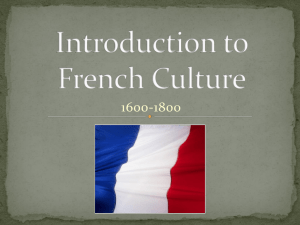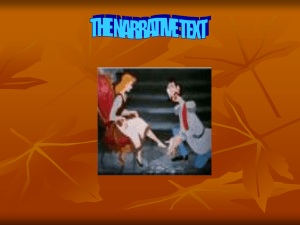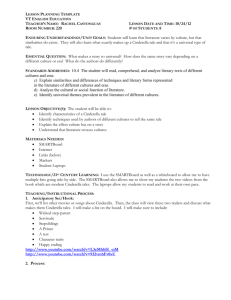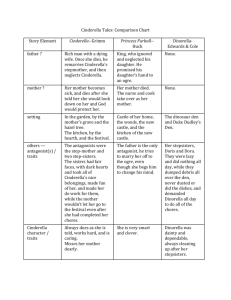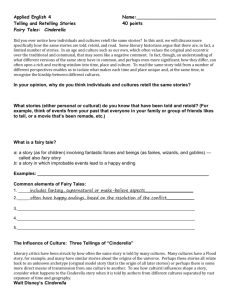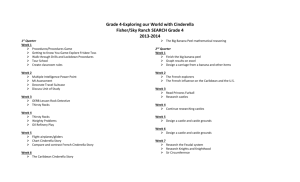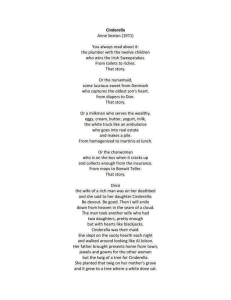Fairy Tales - Real Classroom Ideas
advertisement
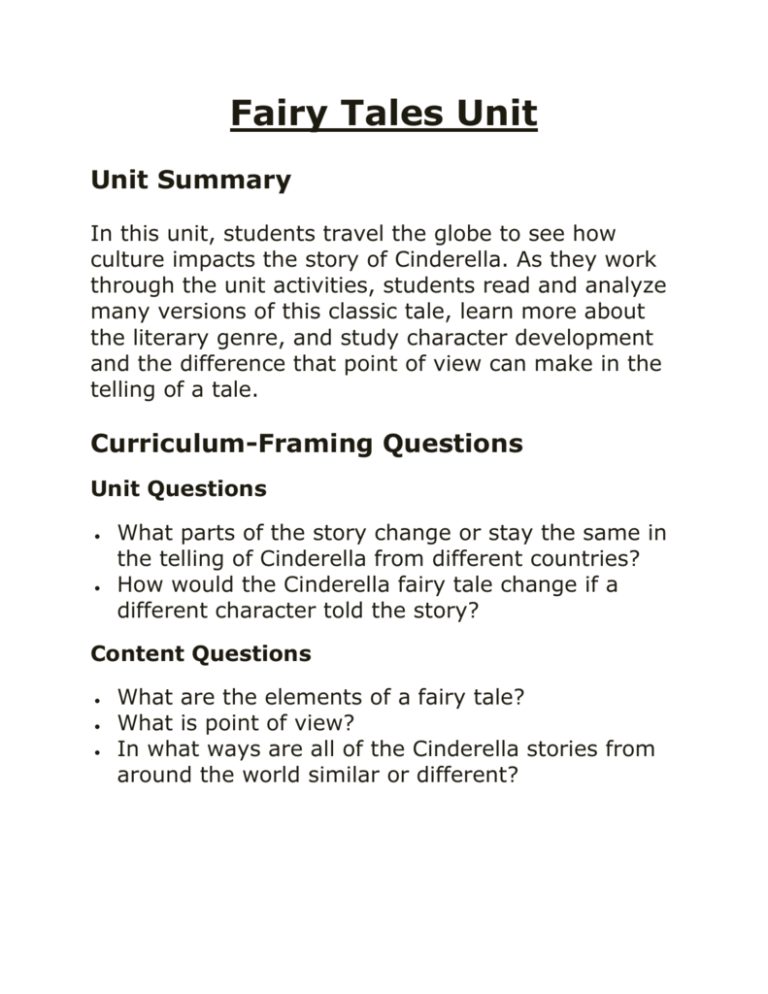
Fairy Tales Unit Unit Summary In this unit, students travel the globe to see how culture impacts the story of Cinderella. As they work through the unit activities, students read and analyze many versions of this classic tale, learn more about the literary genre, and study character development and the difference that point of view can make in the telling of a tale. Curriculum-Framing Questions Unit Questions What parts of the story change or stay the same in the telling of Cinderella from different countries? How would the Cinderella fairy tale change if a different character told the story? Content Questions What are the elements of a fairy tale? What is point of view? In what ways are all of the Cinderella stories from around the world similar or different? Instructional Procedures Prior to Instruction Compile a collection of Cinderella stories from a variety of cultures. Prepare bookmarks to use during readings to guide critical thinking and understanding of the Cinderella versions across cultures. Part 1 Begin by asking students if they all know the basics of the Cinderella story, either from reading a book or watching a movie. Most will know it. For those who do not, have them shadow another student during the next activity. Have students pair up to tell the story to each other. Then have pairs meet with other pairs to tell the story among themselves again. They will find that they agree on some parts and disagree on others. This is a great opportunity to talk about how stories develop and are interpreted differently all over the world. Clarify that Walt Disney is not the author of Cinderella, but that he interpreted it from Perrault’s early version that most of us know. Read aloud and discuss elements of the fairy tale. Illustrate how fantasy and realism play important roles in the development of a fairy tale. Introduce the concept of point of view in storytelling. Tell students there are many versions of Cinderella from different countries and that they will have an opportunity to read several versions. Discuss with students the elements of a fairy tale. Show students how to use their bookmarks as a guide for keeping a journal of connections, by modeling how to use focus questions, mental images, inferences, and big ideas as you read the different versions of Cinderella. After reading, show students how to use the Cinderella connection graphic organizer to map key components of the story. Model how to create a list of new and unusual words, particularly those with cultural importance. Discuss how customs, family structure, setting, and time period influence the story of Cinderella. Use a Venn diagram to compare the cultural versions with the common Cinderella story. Part 2 Have students follow the same comparison process with other versions of Cinderella. To meet the diverse needs and interests of students, provide a wide variety of reading material at different levels of difficulty. To reinforce reading comprehension, have students use Venn diagrams to compare and contrast the Cinderella stories they read with Perrault’s Cinderella story. Have cooperative groups develop a multimedia presentation comparing and contrasting each story. Distribute and review the presentation rubric to help students monitor their progress as they work on the presentations. The presentation rubric can also be used to formally assess the presentations. Part 3 Pose the Unit Question, How would the Cinderella fairy tale change if a different character told the story? Pose the Content Question, What is point of view? Discuss points of view in fairy tales. Divide students into small groups and assign one of the characters (Cinderella, Fairy Godmother, Evil Stepmother, Ugly Stepsister, or Prince) from Cinderella to each. Then discuss the concept of point of view and how it can impact a story. Tell students that their task will be to work as a team to rewrite the story of Cinderella from the assigned character’s point of view in a blog* or story form. Read The True Story of the Three Little Pigs by Jon Scieszka. Discuss how the story changed when told from the wolf’s point of view. Also, point out and discuss how different the story reads when told through the voice of a character, rather than a narrator. Give students the blog or story rubric to help them as they work on their writing. Have students plan their story ideas using graphic organizers, lists, timelines, storyboards, or any brainstorming technique that works for them. Observe teams as they work, asking questions and taking anecdotal notes on their progress. Use these notes to plan instruction and coaching on collaboration and self-direction skills. After students generate their initial story ideas, revisit the literary element of point of view and ask students to make sure it is included in their story ideas. Place students in small groups to get feedback on their blogs or stories. The peer feedback form helps authors to organize their thoughts and guides peers to provide constructive feedback. Allow plenty of time for teams to draft, write, and publish their work. Part Five Visit engaging Cinderella Web sites to share other story and presentation ideas. Ask students to use a character from one of their group’s stories to create “Wanted” posters. A poster may be of a notorious character from the story or it may highlight a hero or heroine by creating a “Wanted Happily Ever After” poster. Posters should reflect characteristics and deeds linked to the character, who may be looking for him or her, and any reward associated with finding the character. In all instances, poster information needs to be based on information from the story (evidence). Make sure to post the project requirements for students to see while they create their posters. Plot locations on a world map to show the places Cinderella stories have taken the class. Discuss how place, time, and culture influence the story. Part Six Pose the Unit Question, What would happen in a modern day Cinderella story? Have students brainstorm an initial list of answers to the question. Together, read a contemporary story, such as The English Roses by Madonna. Then, review the student list to determine whether the modern version included any of their ideas. To dig deeper, instruct students to select a favorite character from all the stories they have read and ask them to consider how the character’s traits might be applied to a “Thoroughly Modern Cinderella” story and how they might adapt their favorite character’s traits to a modern-day rendition. Invite students to write their own Cinderella stories. To begin, pass out the character analysis graphic organizer to help students look deeper into character. Demonstrate how the completed organizer can aid the story development process. Some students may need extra direction to help them plan their story ideas. Suggest using graphic organizers, lists, timelines, storyboards, or any brainstorming technique that works for them. Observe students while they work, asking questions and taking anecdotal notes on their progress. After students have drafted their stories, give them the peer feedback form, and assign each student to small peer review groups for feedback. They can then refine and elaborate their stories by using the suggestions from their peers. Optional Extension Activity At the end of part four, contact a local bookstore where published authors hold book signings and read their work aloud. See if the bookstore will host a student writers’ night for your class. Assist the bookstore by having students complete author brochures about themselves and the fairy tales they wrote. Invite parents and other community members to attend the event. Prerequisite Skills Word processing skills Internet searching proficiency File management skills Basic spreadsheet experience Differentiated Instruction Special Needs Student Make modifications as dictated in the student's IEP Use cooperative grouping Provide written and oral instructions in a variety of ways Allow extra time for completing assignments Work with a parent or a teacher's aide for assistance Provide teacher-created templates to guide work Provide positive reinforcement for each accomplished benchmark Gifted/Talented Student Have the student create a timeline of the Cinderella stories from around the world Have the student predict how the story would evolve in the year 2025 and write a future Cinderella story for different cultures Encourage the student to create a multicultural mural Have the student write an essay on why no one Cinderella story is the "true" version Nonnative Speaker Have the student share the Cinderella story of their culture of origin Use cooperative grouping Use visuals and illustrations to develop vocabulary and understanding Encourage support from common language speakers who are more proficient in English Provide extra time for completing assignments Enlist assistance from a parent or a teacher's aide Credits A teacher participating in the Intel® Teach Program developed this idea for a classroom project. A team of teachers expanded the plan into the example you see here.
